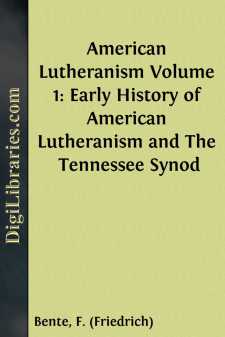Categories
- Antiques & Collectibles 13
- Architecture 36
- Art 48
- Bibles 22
- Biography & Autobiography 813
- Body, Mind & Spirit 142
- Business & Economics 28
- Children's Books 17
- Children's Fiction 14
- Computers 4
- Cooking 94
- Crafts & Hobbies 4
- Drama 346
- Education 46
- Family & Relationships 57
- Fiction 11829
- Games 19
- Gardening 17
- Health & Fitness 34
- History 1377
- House & Home 1
- Humor 147
- Juvenile Fiction 1873
- Juvenile Nonfiction 202
- Language Arts & Disciplines 88
- Law 16
- Literary Collections 686
- Literary Criticism 179
- Mathematics 13
- Medical 41
- Music 40
- Nature 179
- Non-Classifiable 1768
- Performing Arts 7
- Periodicals 1453
- Philosophy 64
- Photography 2
- Poetry 896
- Political Science 203
- Psychology 42
- Reference 154
- Religion 513
- Science 126
- Self-Help 84
- Social Science 81
- Sports & Recreation 34
- Study Aids 3
- Technology & Engineering 59
- Transportation 23
- Travel 463
- True Crime 29
American Lutheranism Volume 2: The United Lutheran Church (General Synod, General Council, United Synod in the South)
Categories:
Description:
Excerpt
MERGER.
1. Origin of the New Body.—On April 18, 1917, at Philadelphia, the Joint Quadricentennial Committee, appointed by the General Synod, the General Council, and the United Synod in the South to arrange for a union celebration of the Reformation, decided that the merging of the three affiliated general bodies would be "the fittest commemoration and noblest memorial of the four-hundredth Reformation Jubilee." Accordingly, the presidents of these bodies, being present, were requested to form a joint committee, which should prepare a constitution for a united Church and present the same to the three general bodies for their consideration, and, if approved, for submission to the District Synods. The constitution, framed by the committee, was in the same year adopted by all of the three general bodies, the General Synod, which, in 1820, had been founded for the express purpose of uniting all Lutheran synods in America, being the first to assent to the Merger during its session at Chicago, June 20 to 27, 1917. The various District Synods also having approved of the union and having ratified the constitution, the Merger was consummated at New York City, November 15, 1918. Dr. F. H. Knubel, a member of the General Synod, was elected President of the new body— "The United Lutheran Church in America." Of the total number of Lutherans in America (63 synods, 15,243 congregations, 9,790 pastors, 2,450,000 confirmed and 3,780,000 baptized members) the United Church embraces 45 synods, 10 theological seminaries with 46 professors and 267 students, 17 colleges, 6 academies, 3,747 congregations and mission-posts, 2,754 pastors, almost 1,000,000 baptized members, and 758,000 confirmed members, the General Synod contributing 364,000, the General Council 340,000, and the United Synod in the South 53,000. The United Church is the second largest Lutheran body in America, the Synodical Conference outnumbering it by only about 50,000 confirmed members. The merged bodies will continue to exist legally until no property rights are imperiled. In 1919 it was decided to consolidate the Lutheran, the Lutheran Church Work and Observer, and the Lutheran Church Visitor. The new church-paper will be The Lutheran, with Dr. G. W. Sandt as editor-in-chief.
2. Refusing to Enter the Merger.—The United Lutheran Church, according to the Lutheran, "has inaugurated a new era of progress for our beloved Lutheran Church. . . . Three names have gone down, but a new and greater name has arisen from their ashes." This, however, was not the view of the Iowa and Augustana synods, though both indirectly, through their connection with the General Council, had for years been in church-fellowship also with the General Synod, hence, consistently might have entertained scruples to join the Merger no more than the Council. When, at Philadelphia, October 25, 1917, the General Council passed on the Merger, Dr. M. Reu, the representative of the Iowa Synod, was the only delegate (advisory) who voted against it....





